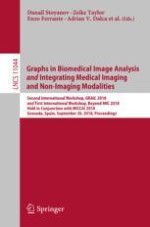2018 | OriginalPaper | Buchkapitel
Multi-modal Disease Classification in Incomplete Datasets Using Geometric Matrix Completion
verfasst von : Gerome Vivar, Andreas Zwergal, Nassir Navab, Seyed-Ahmad Ahmadi
Erschienen in: Graphs in Biomedical Image Analysis and Integrating Medical Imaging and Non-Imaging Modalities
Aktivieren Sie unsere intelligente Suche, um passende Fachinhalte oder Patente zu finden.
Wählen Sie Textabschnitte aus um mit Künstlicher Intelligenz passenden Patente zu finden. powered by
Markieren Sie Textabschnitte, um KI-gestützt weitere passende Inhalte zu finden. powered by
